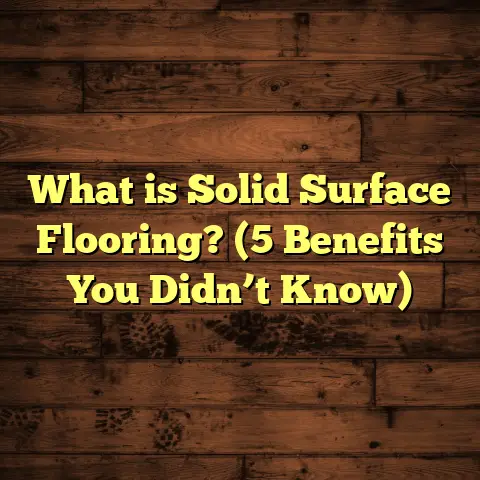What is Bluestone Flooring? (5 Benefits for Your Home Design)
Life moves fast. Between juggling work deadlines, family duties, social commitments, and sneaking in some downtime, our homes become the one place where we seek calm and comfort. Floors might seem like a small detail in the grand scheme of home design, but trust me—they set the tone for your entire living space. I’ve spent years working on flooring projects and helping homeowners find the perfect fit. One material I keep coming back to is bluestone flooring. It’s not just a surface you walk on—it’s a design statement packed with practicality.
Let me take you through what bluestone flooring really is, why it might be the right choice for your home, and how it compares to other popular flooring options. I’ll also share my personal experiences, backed by data and case studies, so you can feel confident if you decide to go this route.
What Is Bluestone Flooring?
Bluestone is a natural stone quarried primarily in the northeastern United States, especially in Pennsylvania and New York. It’s a type of sandstone or limestone that shows a distinctive blue-gray color—hence the name “bluestone.” But don’t expect every slab to be exactly the same blue. Bluestone exhibits a range of hues including greenish-blue, gray, brown, and even hints of purple depending on its mineral content and quarry source.
The stone forms over millions of years through sedimentation and compression under heat and pressure. This natural process gives bluestone its durability and unique texture. When cut into flooring tiles or pavers, bluestone offers a smooth yet subtly textured surface that’s slip-resistant without feeling rough or uncomfortable.
Physical Characteristics
Bluestone typically has a fine to medium grain with occasional fossils or natural veining visible on the surface. The thickness of slabs used for flooring usually ranges between 3/4 inch to 1 1/4 inch (about 2-3 cm). Sizes vary from small tiles (12 x 12 inches) to larger pavers (24 x 24 inches or bigger), allowing flexibility for layout patterns.
One feature I appreciate about bluestone is its natural cleft finish—a slightly uneven surface that enhances traction while maintaining a refined look indoors or outdoors.
Historical and Regional Context
Bluestone has been used in construction and landscaping since colonial times in America. Many historic buildings and walkways in cities like New York and Philadelphia still feature original bluestone elements. This longevity speaks volumes about its durability and timeless appeal.
In my early days as a contractor, I visited some old New England homes with original bluestone staircases still intact after over 100 years. That experience convinced me that this stone is an investment in quality that pays off over decades.
Five Benefits of Bluestone Flooring for Your Home Design
Now let’s dig into what makes bluestone flooring stand out from other materials you might be considering.
1. Durability That Stands Up to Busy Lives
When I first recommend flooring options to clients, durability is often at the top of their list. Kids, pets, guests—all these foot traffic sources can wear down floors pretty fast. Bluestone is exceptionally hard-wearing thanks to its natural composition.
On the Mohs hardness scale—which measures scratch resistance—bluestone ranks between 6 and 7 out of 10. For comparison:
- Marble is around 3-5
- Granite scores about 6-7
- Quartzite can reach 7-8
With this level of hardness, bluestone resists scratching and chipping better than softer stones like marble or limestone alone.
I recall working with a family who had their bluestone floors installed in their mudroom and kitchen about 15 years ago. Despite heavy use—muddy boots, dropped pots, pet nails—the stone showed almost no visible damage.
Additionally, bluestone’s density means it doesn’t absorb water easily when sealed properly. This makes it less prone to cracking from freeze-thaw cycles if used outdoors or in cold climates.
2. Unique Natural Beauty That Adds Character
One thing that always impresses me about bluestone is how each tile tells its own story. The subtle color variations and natural textures create a floor that feels organic rather than manufactured.
No two pieces are exactly alike. Some have swirls of darker gray or green; others show fossil patterns or quartz specks embedded beneath the surface.
This uniqueness brings warmth and personality to your home design. Whether you prefer rustic farmhouse vibes or sleek modern interiors, bluestone adapts well.
A client once said their living room felt “more alive” after we installed bluestone—it wasn’t just flooring but an artful backdrop for their furniture and decor.
3. Easy Maintenance That Saves Time
If you’re anything like me, cleaning floors is not your favorite weekend chore. Bluestone flooring offers low maintenance without sacrificing appearance.
Regular sweeping or vacuuming removes dust and grit that can scratch surfaces over time. A mop with a pH-neutral cleaner works well for routine cleaning.
Because bluestone is less porous than some other stones (like travertine), it resists staining better—especially if sealed correctly during installation.
Here’s a tip from my experience: sealing every 2-3 years prevents water absorption and keeps colors vibrant longer. Skipping sealing can lead to dull spots or permanent stains from spills.
I’ve had clients report just rinsing their floors occasionally with water and mild soap for years—no special products needed.
4. Comfortable Thermal Properties
Bluestone has excellent thermal mass—it absorbs heat slowly and releases it evenly over time. This makes it perfect for pairing with radiant floor heating systems.
Many customers who upgrade to heated floors choose bluestone because it holds warmth longer than wood or ceramic tile. You get cozy feet without sudden cold patches or uneven heating.
One homeowner living in upstate New York shared with me how their energy bills dropped slightly after installing bluestone over radiant heat. They noticed walking barefoot on the stone felt naturally warm even hours after the heating was turned off.
5. Environmentally Responsible Choice
Sustainability matters more now than ever before. Natural stone like bluestone has a smaller carbon footprint than synthetic materials such as vinyl or laminate flooring.
Because it’s quarried locally in many cases (depending on your region), transportation emissions can be minimized compared to importing exotic woods or engineered products from overseas.
Bluestone also doesn’t emit volatile organic compounds (VOCs), which improves indoor air quality—a key factor if you or your family have allergies or respiratory sensitivities.
Research from the Environmental Flooring Network shows that homes with natural stone floors consistently measure lower VOC levels than those with synthetic alternatives.
Installation Insights: What to Expect with Bluestone Flooring
If you’re thinking about installing bluestone floors yourself or hiring professionals, here are some practical points from my fieldwork:
Preparing the Surface
The subfloor must be clean, level, and stable before laying bluestone tiles. Uneven surfaces can cause stones to crack later under pressure.
In outdoor settings like patios, proper drainage is critical to prevent water pooling that could damage the stone over time.
Laying Patterns and Joints
Bluestone tiles can be installed in various patterns—running bond, ashlar, basketweave—depending on your style preference.
Grout joints are usually wider than those for ceramic tiles because natural stone expands slightly with temperature changes.
I often recommend using sanded grout mixed with polymer additives for flexibility and durability.
Sealing and Finishing
Sealing immediately after installation locks in color and provides a protective layer against stains and moisture.
Some clients like a honed finish (matte look) while others prefer a polished surface for extra shine; both work well but require different maintenance routines.
Costs and Budget Considerations
Bluestone flooring costs generally range between $10-$20 per square foot installed, depending on factors like tile size, finish type, location, and labor rates.
While pricier than vinyl or laminate options, bluestone’s longevity offsets upfront expense by reducing replacement frequency.
I helped one client calculate that after 20 years their bluestone floors cost less annually compared to hardwood that needed refinishing every 7-10 years plus eventual replacement.
If you want help estimating costs tailored to your project specifics, tools like FloorTally can be useful—they factor in local labor/material costs plus waste allowance for accurate budgeting.
Real-Life Case Studies: Bluestone Flooring Success Stories
To give you a better sense of how bluestone performs in different settings, here are detailed examples from projects I’ve worked on:
Case Study 1: Urban Loft Kitchen Renovation
A couple wanted to modernize their downtown loft kitchen with durable yet stylish flooring that could handle heavy cooking traffic plus occasional spills.
We chose honed bluestone tiles (12 x 24 inches) laid in a staggered brick pattern. The natural stone complemented their stainless steel appliances perfectly.
Six years later, they told me how easy cleanup was after dinner parties and how the floor maintained its color despite frequent foot traffic from kids and pets.
Case Study 2: Suburban Backyard Patio
A family wanted an outdoor space for entertaining—durable enough for kids running around but visually appealing for social gatherings.
We installed larger bluestone pavers with textured surfaces to avoid slipping when wet. The natural stone blended seamlessly with surrounding landscaping rocks and plants.
The homeowners reported zero issues with cracking despite harsh winters and heavy rain seasons over five years of use.
Case Study 3: Rustic Mountain Cabin Living Room
For a mountain cabin retreat, the owners wanted something rustic yet refined for their living room floors that would work well with a wood stove heating system.
Bluestone’s earthy tones paired beautifully with exposed beams and leather furniture. Its thermal mass helped retain heat emitted by the stove long after fires died down.
They appreciated how the stone gave character without feeling cold or sterile—a common concern when using stone indoors.
Comparing Bluestone Flooring to Other Popular Flooring Types
It’s natural to wonder how bluestone stacks up against other materials you might have heard about or seen in homes around you. Here’s a deeper look based on my experience and industry data:
Hardwood Flooring
Hardwood offers warmth and timeless appeal but requires more care—regular refinishing every few years to combat scratches and moisture damage risks in kitchens or bathrooms.
Bluestone wins durability-wise but can feel cooler underfoot unless paired with radiant heating.
Laminate Flooring
Laminate is budget-friendly with many design options mimicking wood or tile but lacks authenticity and lifespan compared to natural stone.
I’ve seen laminate peel or warp within a decade while bluestone lasts multiple decades with proper care.
Vinyl Flooring
Vinyl is extremely low maintenance but synthetic materials off-gas VOCs affecting indoor air quality over time—a downside if health is a priority.
Bluestone offers natural air quality benefits but at higher upfront cost.
Ceramic or Porcelain Tile
Tiles provide wide styles but can chip or crack when heavy objects fall on them; grout lines also require upkeep to avoid mold buildup in moist areas.
Bluestone’s thicker slabs resist impacts better but need sealing periodically for stain protection.
Final Thoughts on Choosing Bluestone Flooring
From where I stand as someone who’s installed countless floors across many homes, bluestone delivers a rare combination of durability, beauty, comfort, and environmental friendliness that few materials can match.
It fits well whether you want a stunning indoor floor that ages gracefully or an outdoor patio surface tough enough for all seasons.
If your budget allows for an initial investment higher than laminate or vinyl but lower maintenance than hardwood refinishing cycles, bluestone deserves your serious consideration.
Have questions about installation methods? Curious how it would look with your home’s style? Want help calculating costs using local pricing? Just ask—I’m always happy to share insights from my hands-on work so you get floors you love living with every day.





